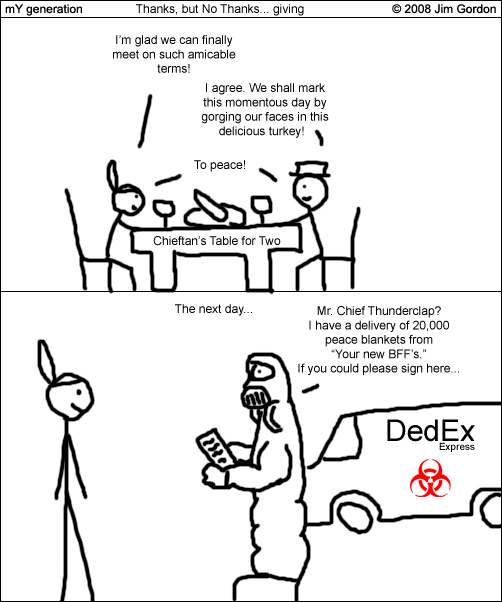|
|
|
Archive for November, 2011
Monday, November 21st, 2011
 Talented managers are taking flack these days for not becoming entrepreneurs. Talented managers are taking flack these days for not becoming entrepreneurs.
Whether hinted at or stated outright, their value is demeaned when they choose to stay in corporate positions and they are accused of wasting their talents when they could be out creating jobs by starting companies.
Kindly put, this is a crock.
As Andy Grove pointed out, after the first couple of years job creation is about the same in growth companies as large corporations.
Now Valley legend Esther Dyson, CEO of EDventure Holdings and an active investor in a variety of start-ups around the world, weighs in pointing out that without managers there would be no companies.
The real spur to job and value creation is not turning hundreds of college grads (or dropouts) into entrepreneurs, but hiring thousands – and hundreds of thousands – of people into growing companies that can organize and motivate them and make the best use of their talents.
Thank you, Esther!
This needed to be said by someone with a lot more clout than I have.
Startups are much like marriages.
In marriage, the real work starts after the bride and groom say “I do.”
In startups, the real work starts when the first “outsider” is hired.
There is a reason that very few founders build and run their companies—it’s not what they’re good at.
That’s why we should be celebrating managers with the talent and skill to build the company for the long-term.
Flickr image credit: HikingArtist
Posted in Leadership, management | No Comments »
Sunday, November 20th, 2011
Jim’s back, but experiencing technical problems, so I’m still raiding the archives.The following is Jim’s first Thanksgiving here. See all mY generation posts here.

Posted in mY generation | No Comments »
Sunday, November 20th, 2011
(Obviously, I’ve been experiencing technical difficulties!)
 Continuing last weeks social assistance to ease those awkward silences that may happen during (gasp) face2face holiday get-togethers. Continuing last weeks social assistance to ease those awkward silences that may happen during (gasp) face2face holiday get-togethers.
Interacting with kids you see only occasionally, or even those you see more often, can be fraught with pitfalls.
Here’s a safe, interesting tidbit to get a conversation going, especially at a tense family dinner when young children are present. Just mention that Walt Disney was afraid of mice, and watch the conversational ball start moving.
Girls are often more chatty than boys and easier to engage. Here are two questions that should generate some interesting commentary, including from any adults present,
- It is possible to lead a cow upstairs, but not downstairs. Why?
- A duck’s quack doesn’t echo, and no one knows why. What do you think?
Gross work better with boys, but you need to watch it since there are usually other generations present that don’t appreciate gorss. That said, here’s one that will bring out the snickers, turtles can breathe through their butts. However, if your audience tries the same trick you will be in big trouble.
Here’s one more to use as you see fit, either as a starter or to shut up a bore, donkeys kill more people annually than plane crashes or shark attacks—good reason to watch your ass or stop acting like one.
Be sure to join me next week for great gambits that will light up all your gardening relatives.
Flickr image credit: meeshypants
Posted in Oddball Facts | No Comments »
Saturday, November 19th, 2011
 Thanksgiving, better known as Stressgiving, marks the official start of the holiday season, so I thought it appropriate to offer up my version of inspirational reading in an effort to mitigate the negative effects. Thanksgiving, better known as Stressgiving, marks the official start of the holiday season, so I thought it appropriate to offer up my version of inspirational reading in an effort to mitigate the negative effects.
A lot of actions this time of year seem focused on tasks instead of people. As folks gear up to get everything on their holiday list done on schedule and in budget, they tend to mow down anybody they perceive to be in their way. It turns out that there is a biologically-based reason that this happens and it isn’t limited to people in leadership positions. I find knowledge like this useful; it makes me more tolerant of others when they are acting like twits and lessons the likelihood that I’ll do the same.
The other challenge is that the circuitry for thinking analytically, such as thinking about the future or about concepts, switches off the circuitry for thinking about others. People spending a lot of time being analytical, conceptual or goal focused may have diminished circuitry for thinking about the minds of others, simply through lack of use.
With the holidays upon us anything that keeps saving, as opposed to spending, front and center is worthy of your attention. Startup SaveUp does just that and makes it cool enough to interest kids and teens.
The dollars-to-points ratio translates to one dollar per point. Thus, for every dollar you put in your savings account or use to pay down your debt, you earn one point, and once you’ve accumulated 10 points, you can enter any prize play of your choice. All prize plays cost 10 credits—which means you can use those 10 credits to enter a drawing for an iPad 2 or you can use them to enter a drawing to get $10,000 of your debt paid off.
Finally, if you’re looking to store some of your stuff and happen to live in New York City then you can do it in style for a modest $300 a month.
Behind the mute facade of a largely windowless neo-Gothic tower lies an ingenious system of steel vaults traveling on rails. Within those armored containers, which have been in continuous use since the Jazz Age… Day & Meyer, Murray & Young warehouse, and since it opened in 1928 it has been the storage building of choice for many of New York’s wealthiest families, most prestigious art dealers and grandest museums.
Have a wonderful weekend.
Flickr image credit: pedroelcarvalho
Posted in Expand Your Mind | No Comments »
Friday, November 18th, 2011
A Friday series exploring Startups and the people who make them go. Read all If the Shoe Fits posts here
 Today is not another rehash of the Zynga fiasco or CEO Mark Pincus’ follow-up email to the troops. Today is not another rehash of the Zynga fiasco or CEO Mark Pincus’ follow-up email to the troops.
What I found fascinating is that the entire problem could have been averted by using Option Sanity™.
Seriously.
Yes; I know; every founder believes his or her product is the perfect solution in its nitch, but rarely are we gifted with such a high profile, real-life demonstration.
Rather than simply firing under-performing employees and handing unvested options over to the replacement, Pincus often likes to find another position within Zynga where the employee might still be able to contribute. But because that new position was often lower down the corporate totem poll, Pincus basically wanted to cut the person’s compensation by reducing his or her number of unvested options (vested options were not touched).
Some say bad hires just shouldn’t happen, while others accept them as a normal part of business and believe fast hire/fast fire is the right approach.
I believe Pincus’ approach to a miss-hire is valid; in the heat of a high growth hiring frenzy managers do hire good people for the wrong positions, oft times because candidates oversell their experience and/or managers are desperate to fill their openings.
Think of it as a people pivot—repositioning talent for the good of the company.
The problem is that any unexpected changes made after the fact, no matter how valid, breach the social contract and, in doing so, break trust.
The hiring errors and the associated stock grants should have been corrected as soon as they were identified. Waiting until just before the IPO significantly exacerbates the damage to both Zynga’s and Pincus’ street rep and puts employee morale in the toilet.
It’s a different result when incentive stock grants are based on a transparent, fair, structured methodology that everyone understands, especially when it’s rooted in the company’s stated values/culture.
A methodology that
- assigns positions to levels based on its ability to influence the company’s success as opposed to urgency or charm and history of the candidate;
- assigns an ISO baseline to each level that dictates both the initial hiring grant and
- the Annual Stock Bonus, so that a significant portion of each person’s stock rewards are based on the actual success of the company over time, as measured against quantified annual goals approved by the Board;
- allocates based on the current risk level as defined by set milestones; and
- spells out what happens for both promotions and demotions
It’s easiest to put that structure in place at the very beginning when it’s just the founders.
That’s why we provide Option Sanity™ free for six months to any startup with fewer than four people.
(Feel free to email me or call 866.265.7267 for more information or if you are just curious.)
Option Sanity™ prevents Zyngavitis
Come visit Option Sanity for an easy-to-understand, simple-to-implement stock process. It’s so easy a CEO can do it.
Warning.
Do not attempt to use Option Sanity™ without a strong commitment to business planning, financial controls, honesty, ethics, and “doing the right thing.”
Use only as directed.
Users of Option Sanity may experience sudden increases in team cohesion and worker satisfaction. In cases where team productivity, retention and company success is greater than typical, expect media interest and invitations as keynote speaker.
Image credit: hikingartist.com
Posted in Entrepreneurs, If the Shoe Fits, Stock Options | No Comments »
Thursday, November 17th, 2011
 There may be dozens, even hundreds, of entrepreneurs working to start the next Facebook or Google, but, in fact, one part of the entrepreneurial world is shrinking, not expanding. There may be dozens, even hundreds, of entrepreneurs working to start the next Facebook or Google, but, in fact, one part of the entrepreneurial world is shrinking, not expanding.
“VCs tend to invest in people who’ve had good exits, who have successfully had their company acquired. If you’ve had two good exits, you know the person isn’t a fluke.” –Ross Bott, CEO of Seven and former CEO of OneBox
“William Goldman famously responded to the question, How do you predict box-office success? with the answer ‘No one knows anything. That’s why Hollywood overpays for top-drawer stars.’ The exact same thing happens in the world of startups. If you’re a serial entrepreneur with at least one success behind you, you can almost always find a host of investors who will overpay for your next startup because nobody knows anything.” –Paul Kedrosky, Silicon Valley investor and commentator
(Quotes from a profile of Bill Nguyen in Fast Company)
While talent, intelligence and vision are useful, funding flows most often to the verbally skilled, as the profile on Nguyen shows.
And although there are many more entrepreneurs, the majority have far fewer ways to meet likely investors.
In order to be heard entrepreneurs need credibility, which is rarely measured in how many followers or friends they have.
Rather, as in ages past, it comes down to who you know—again, not followers, friends or even connections, but actually know.
Know as in ‘I will introduce you because I know you well enough to put my reputation on the line and tell X that you are worth his/her time.’
Incubators are hailed as a solution, but all incubators are not created equal—kind of like colleges, fraternities and sororities, some have more prestige and offer better alumni networks than others.
Again, who you know matters.
Social media is no panacea; they promote themselves as being able to evaluate “influence,” but is that influence real? Too often it’s the result of knowing how to play the I’ll-scratch-yours-if-you’ll-scratch-mine game.
Not that there’s much choice; it’s pretty much use the available tools, because it take too long to invent new ones and have them adopted.
The passage of HR2930 opens a new avenue in the form of crowd funding, which may lower the initial connecting/funding hurdle for new and unconnected entrepreneurs.
Flickr image credit: HikingArtist.com
Posted in Entrepreneurs | No Comments »
Wednesday, November 16th, 2011
Perhaps today WW should stand for Wednesday w/ Words because there are a few.
Imagine 100 objects that are said to depict the entire history of our world, such as this carving from 11,000 years ago.

The words explaining the British Museum project are here.
A slide show of ten of the objects is here.
The stories, as told in the BBC radio series, are here (by far the most captivating choice).
Image credit: Wikimedia Commons
Posted in Wordless Wednesday | No Comments »
Tuesday, November 15th, 2011
 I write a lot abut the importance of culture and now and then someone calls or writes asking why I keep harping on it (BTW, I love when readers call, that’s why there’s a toll-free number in the right-hand column.) I write a lot abut the importance of culture and now and then someone calls or writes asking why I keep harping on it (BTW, I love when readers call, that’s why there’s a toll-free number in the right-hand column.)
I’m not the only one fixated on the role culture plays in everything from acquiring, motivating and retaining employees to creativity, innovation and overall company success.
- Booz’ strategy + business annual innovation survey focuses on culture, not money to improve results.
Booz & Company’s annual study shows that spending more on R&D won’t drive results. The most crucial factors are strategic alignment and a culture that supports innovation.
“My turnover was non-existent. Our turnover is only two percent. We also hire the right people almost every time, because we know that core values are more important than skills. We can teach the skills. Now that we’re all aligned for what the vision is and what’s important to us as humans, we have a culture of resilience and efficient productivity.”
- Lani Hay, founder/CEO of defense contracting company Lanmark Technology, turned over three COOs in the same year she won a prestigious national women’s entrepreneurship award and quadrupled company revenues.
“I don’t want to let anyone in the corporate culture who’s going to disrupt the culture and isn’t a good fit.” … Hay says she’s learned that she needs to listen to a wider array of Lanmark staffers, and make sure she values effective communications and an ability to work well with her team. She’s also paying more attention to cultural fit in hiring.
And for those looking to improve hiring there is no better screening tool than culture.
The biggest complaint I hear is that “culture stuff takes so much time” and I suppose that’s true when culture is applied like paint instead of stain.
Flickr image credit: zedbee
Posted in Culture, Ducks In A Row | 4 Comments »
Monday, November 14th, 2011
“There is no silver bullet that’s going to fix that. No, we are going to have to use a lot of lead bullets.” ––Bill Turpin (quote source)
 Although Bill Turpin said this in reference to technical problems at Netscape, I see managers at all levels and across industries spending time looking for silver bullets with which to “fix” their people. Although Bill Turpin said this in reference to technical problems at Netscape, I see managers at all levels and across industries spending time looking for silver bullets with which to “fix” their people.
There are two reasons that this is a major waste of time.
First, I can categorically state that there is no such thing as a silver bullet. No matter what you are trying to do there is no tool or methodology that can be guaranteed to work in every situation and under every circumstance.
Second, No manager, past or present, has ever fixed anyone. The best that any manager can do is identify the problem, present the information and offer support, but any change or ‘fixes’ must come from the individual.
Lead bullets, however, are how most problems are solved and behaviors changed.
By some measurements lead bullets are expensive, since they cost time and effort over a longer period, but they typically have the highest ROI of anything a manager does.
So, time spent searching for a silver bullet fix or time spent chipping away at the problem with lead bullets?
As always, it’s your choice.
Flickr image credit: mdanys
Posted in management, Personal Growth | 1 Comment »
Sunday, November 13th, 2011
See all mY generation posts here.
Back in 2008 Jim invented a game based on Monopoly that he called ‘econopoly’; sadly it’s as true now as it was then. And although Bear Sterns is gone, its place is safe in the hands of Bank of America.

Posted in mY generation | No Comments »
|
 Subscribe to
Subscribe to
MAPping Company Success
About Miki 
Clarify your exec summary, website, etc.
Have a quick question or just want to chat? Feel free to write or call me at 360.335.8054
The 12 Ingredients of a Fillable Req
CheatSheet for InterviewERS
CheatSheet for InterviewEEs™
Give your mind a rest. Here are 4 quick ways to get rid of kinks, break a logjam or juice your creativity!
Creative mousing
Bubblewrap!
Animal innovation
Brain teaser
The latest disaster is here at home; donate to the East Coast recovery efforts now!
Text REDCROSS to 90999 to make a $10 donation or call 00.733.2767. $10 really really does make a difference and you'll never miss it.
And always donate what you can whenever you can
The following accept cash and in-kind donations: Doctors Without Borders, UNICEF, Red Cross, World Food Program, Save the Children
*/
?>About Miki
About KG
Clarify your exec summary, website, marketing collateral, etc.
Have a question or just want to chat @ no cost? Feel free to write
Download useful assistance now.
Entrepreneurs face difficulties that are hard for most people to imagine, let alone understand. You can find anonymous help and connections that do understand at 7 cups of tea.
Crises never end.
$10 really does make a difference and you’ll never miss it,
while $10 a month has exponential power.
Always donate what you can whenever you can.
The following accept cash and in-kind donations:
|
 Talented managers are taking flack these days for not becoming entrepreneurs.
Talented managers are taking flack these days for not becoming entrepreneurs.




 Continuing last weeks social assistance to ease those awkward silences that may happen during (gasp) face2face holiday get-togethers.
Continuing last weeks social assistance to ease those awkward silences that may happen during (gasp) face2face holiday get-togethers. Thanksgiving, better known as Stressgiving, marks the official start of the holiday season, so I thought it appropriate to offer up my version of inspirational reading in an effort to mitigate the negative effects.
Thanksgiving, better known as Stressgiving, marks the official start of the holiday season, so I thought it appropriate to offer up my version of inspirational reading in an effort to mitigate the negative effects. Today is not another rehash of the
Today is not another rehash of the  There may be dozens, even hundreds, of entrepreneurs working to start the next Facebook or Google, but, in fact, one part of the entrepreneurial world is shrinking, not expanding.
There may be dozens, even hundreds, of entrepreneurs working to start the next Facebook or Google, but, in fact, one part of the entrepreneurial world is shrinking, not expanding.
 I write a lot abut the importance of culture and now and then someone calls or writes asking why I keep harping on it (BTW, I love when readers call, that’s why there’s a toll-free number in the right-hand column.)
I write a lot abut the importance of culture and now and then someone calls or writes asking why I keep harping on it (BTW, I love when readers call, that’s why there’s a toll-free number in the right-hand column.) Although Bill Turpin said this in reference to technical problems at Netscape, I see managers at all levels and across industries spending time looking for silver bullets with which to “fix” their people.
Although Bill Turpin said this in reference to technical problems at Netscape, I see managers at all levels and across industries spending time looking for silver bullets with which to “fix” their people.

